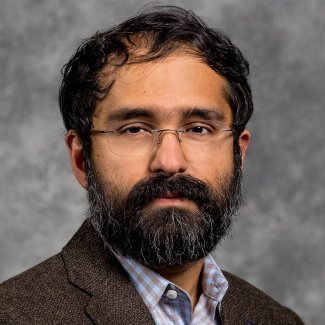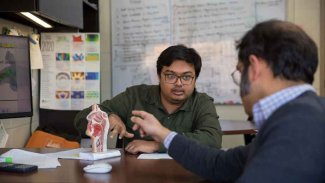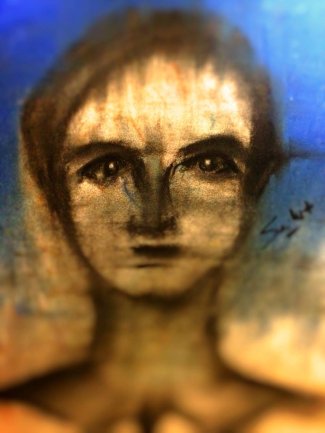In late March, Saikat Basu, an assistant professor in South Dakota State University's Jerome J. Lohr College of Engineering, received notice that he has been named the recipient of the Lohr College of Engineering's Early Career Investigator of the Year award.
"I am grateful, humbled and surprised by the award," Basu said. "I work with a great group of colleagues and students here at South Dakota State University."
While Basu, a faculty member in the Department of Mechanical Engineering, says he was surprised by the award, he really shouldn't have been. His work—which focuses on theoretical and computational fluid mechanics models of transport in complex biomedical systems—is impactful and continually cited by other scholars and researchers in his field.

Having started at SDSU in 2019, Basu is still relatively early in his faculty career, but has already made significant contributions to his field, particularly the research that was completed during the COVID-19 pandemic. Basu considers this work—which investigated how upper airways impact the transmission of the SARS-CoV-2 virus and obtained key details related to the disease by merging fluid dynamics insights with virology parameters (e.g., how many virions can actually trigger airway infection in an exposed subject and the droplet/aerosol sizes that predominantly carry viral load to the infected tissues)—to be the highlight of his career thus far. Because the bulk of this research occurred during the height of the pandemic, Basu worked alone and thus published a single-authored paper—a rarity for faculty members in the early stages of their careers.
"It was a big responsibility for me to have the sole ownership of the paper—which, was clear to me, will have a significant role in determining the direction of mechanics-based respiratory transmission research," Basu said.
This work was published in an influential scientific journal, Scientific Reports – a peer-reviewed, open-access mega journal published by Nature Portfolio. The major finding from the paper was the number of virus particles it took to get one sick, which Basu found to be around 300. A number of experimental studies have since validated Basu's findings. The World Health Organization made a repository of free to use journals related to COVID-19 research to help future researchers and scientists. Basu's works were among those included.
"Dr. Basu’s work is exemplary, both from advancing fundamental research as well as its potential for wide-ranging applications," said Rajesh Kavasseri, associate dean for research for the Lohr College of Engineering. "The efforts elevate the stature of the Lohr College, transcending regional and national boundaries to being globally and societally impactful."
"With the work that was done, hopefully it will help with the next pandemic—even if we don't see it in our lifetime, it will hopefully help the next generation," Basu said.
Early years
One of the lasting impacts the pandemic had on Basu has been his growing interest on the many real-life applications of fluid mechanics—which touches disciplines like biology, chemistry and biomedical engineering. Of course, if you would have asked a high school aged Basu, a Calcutta, India native, if he would be working in those fields during his professional career, he would have had a nice laugh.
"Between seventh and 12th grades, classes in India are very intense and that's when I fell in love with mathematics," Basu said. "I really used to hate chemistry and biology, which is funny because I do a lot of applied work in those fields now, especially biology."
Growing up in a middle-class Bengali family, Basu and his younger brother, Swastik, were always encouraged by their parents, Anindita and Subrata Basu, to aspire for and work diligently toward academic success. In India—after 12th grade—an entrance exam is required to get into engineering or medical school. Basu's father, who worked for a public bank in India, wanted his two sons to become doctors. He had dropped out of medical school after getting an offer to work at a prestigious banking job but hoped his sons would continue his path on the medical school route. When it was time for Basu to make the decision on whether or not he wanted to become a doctor, he decided against it as he disliked biology and chemistry—two key components to success in medical school.
"I did not go to medical school and instead decided to pursue engineering by taking the engineering entrance exam; I am glad that my mother, a teacher of Bengali, and also eventually my father supported my decision," Basu said.
While his options were somewhat limited due to India's post-examination ranking system, Basu chose to pursue a civil engineering degree. His decision was influenced by India's History Channel, which often aired segments on the U.S.'s Space Exploration program from the '60s and '70s.
"I watched these documentaries, and there were guys in white shirts and black ties designing rockets and rocket motion has a lot of fluid mechanics to it but it also has a lot of structural mechanics," Basu said. "I knew that civil engineers have a specialty in structural dynamics and vibrations that could be used for aerospace engineering. My thinking was, if I go into civil engineering then maybe if I go to grad school, I can do aerospace engineering."
After his first year of civil engineering courses, Basu's dream of aerospace engineering began to slowly fade away as he became enamored with fluid mechanics.
"I really fell in love with fluid mechanics because it has a lot of mathematics to it," Basu said. "It also had that aerospace engineering elements as well."
Basu's biggest motivation to become involved in this field? The main equation in fluid mechanics—the Navier Stokes equation—is still unsolved.
"It was in the 1800s when the equation was first drafted but we still don't have a general solution for this equation," Basu explained. "It's one of the million dollar claim problems announced by the Clay Mathematical Institute—if someone can solve that equation, they can still claim a million dollars."
As Basu explains, if the entire field is built on an equation whose general form hasn't been solved yet, it shows that many things are still left to be discovered.
"That was one reason why I took fluid mechanics because there is just so much to do just in terms of pure math," Basu said. "There's so many unknowns and the math is not well charted yet."
From graduate school to researcher
After graduating from Jadavpur University in 2009, Basu—like many graduates—began looking for post-grad opportunities in the U.S. He knew he wanted to continue the fluid mechanics route but there were some challenges. According to Basu, it is rather uncommon for people with a civil engineering background to venture straight into fluid mechanics.
"Many graduates, with similar aptitude in applied mathematics, end up going into structural and solid mechanics fields," Basu said.

Basu began applying to various colleges and universities and was getting offers for positions in groups focused on either solid mechanics or structural. He got one offer for a fluid mechanics position: Virginia Tech.
"That was the reason I ended up attending that school," Basu said.
Despite getting offers from schools that are ranked higher, Basu decided on Virginia Tech because they offered him a position in a field that he was the most interested in. The research group was headed by Mark Stremler, a leading figure on theoretical analysis of flow physics phenomena.
"I think this is a moral that young scientists should always follow, it's not so much about the university's ranking or the profile," Basu said. "It's more important that you like and enjoy the topic that you are going to go into."
At Virginia Tech, Basu focused on theoretical fluid mechanics—one of the three main branches of fluid mechanics—something he enjoyed due to the large amount of mathematics that is required. This was also the topic that his dissertation focused on.
"I really enjoyed it, I loved that work and I still love that work," Basu said. "The thing is, as times change, there is not much research funding in theoretical fluid mechanics. We don't really get funded to solve equations on paper anymore."
During his graduate studies, Basu came to the realization that he someday wanted to be a professor. Unfortunately, because he was focused on theoretical fluid mechanics, he wasn't publishing papers like his peers in experimental mechanics were. To make himself a more viable candidate in the job market, he decided he needed to expand his academic portfolio. For his post-doc, he found a position at the Okinawa Institute of Science and Technology in Japan where he got a chance to work in a group focused on experimental mechanics.
There were two positives that came from Basu's Japanese excursion: a quality paper that received the prestigious Fluid Dynamics Research Prize from the Japan Society of Fluid Mechanics and a more focused understanding of his academic interests.
"During my first postdoc, I realized the challenges of being an experimentalist and I found out that I personally don't like doing it," Basu said. "I understand the experiments, but I don't like the hands-on work of setting up the actual experiments—I much prefer to be working equations on pen and paper or modeling on a computer.
"That is another thing that young scientists can learn from—you need to go beyond your comfort zone to pick up new skills," Basu added.
While still in Japan, Basu felt he needed to expand his portfolio before jumping into a faculty position. He found his next postdoc position by chance. After a conference in Boston, Basu and his then-fiancée, now wife, Brittany, visited his brother, who was a Ph.D. student in upstate New York. From there, they took a long drive to North Carolina, where Brittany was still working. On the way, they stopped in Blacksburg, Virginia to see Basu’s former professors and colleagues at Virginia Tech. Basu explained to one of them that he was looking for a postdoc position in fluid mechanics and found out that a position was open at the University of North Carolina, Chapel Hill in their medical school—a few miles away from where his fiancée was working. The UNC professor, Julia Kimbell, who had a background in mathematics, was looking for a researcher with proficiency in fluid mechanics. The position was for a National Institutes of Health R01 project for drug delivery for chronic rhinosinusitis.
"I accepted the position, and it helped me learn new things in modeling and computational fluid mechanics," Basu said. "I taught myself about the biomedical clinical projects and those were a very productive two and a half years. Being the only person in the team with a doctoral background in fluid mechanics also helped. I was given a lot of freedom to frame the research questions."
Assuming a faculty role
As his postdoc project was nearing completion, Basu knew he was ready to dive into a faculty role at a university as he now had experience in theory, experiments and computations for the field of fluid mechanics. In January 2019, Basu started as an assistant professor and has been with SDSU ever since.

"Dr. Basu is a brilliant junior faculty who has demonstrated great potential to be a high-achieving researcher and leader," said Yucheng Liu, head of SDSU's Department of Mechanical Engineering. "His achievements in fluid mechanics modeling of transport in complex biomedical systems are very impactful and remarkable. I am very proud of what he has accomplished and believe he will advance his career at SDSU with speed, passion and energy."
The Basu Lab is now highly regarded in the field of fluid mechanics. Basu himself is highly respected in his field, as he is often invited to conferences and meetings around the world. This winter, he traveled to Brisbane, Australia for his first keynote address and was also invited to speak at the Indian Institute of Technology–Bombay, one of the top engineering universities in India.
A seasoned traveler, Basu understands three different languages: Bengali, his native language; Hindi, India's official language; and English, which he learned during his formative years at an English medium school.
Outside of academics, Basu is an avid painter and actually utilizes his artistic ability for some of his research papers and proposals.
"Apart from spending time with our daughter, Uma, who is four years old now, painting is my only hobby," Basu said. "Since becoming a faculty member, I don't find as much time to paint as I used to, but I try to include paintings and sketches in my papers and proposals to explain scientific concepts."
It would be apt to say that creativity is the ingredient that drives Basu’s research program forward.
- Contact:
- Telephone number: 605-688-6161
Republishing
You may republish SDSU News Center articles for free, online or in print. Questions? Contact us at sdsu.news@sdstate.edu or 605-688-6161.

